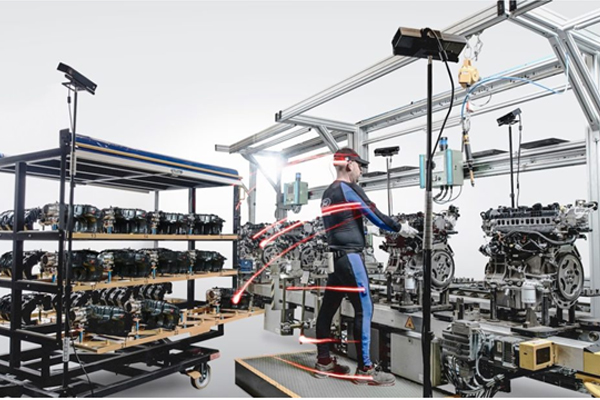|
Car Manufacturer Uses Body Tracking Technology To Improve Worker Posture
Ian Hart, Editor, Safety & Health Practitioner
Technology typically used by the world’s top sport stars to raise their game, or ensure their signature skills are accurately replicated in leading video games, is now being used on a vehicle manufacturing assembly line. Employees at Ford’s Valencia Engine Assembly Plant, in Spain, are using a special suit equipped with advanced body tracking technology. The pilot programme, created by Ford and the Instituto Biomecánica de Valencia, has involved 70 employees in 21 work areas.
It has been part of Ford’s work, since 2003, to reduce the injury rate for its employees worldwide through the introduction of ergonomics technologies and data-driven process changes. The results have seen the company’s assembly line employee injury rate reduce by 70%.
“This is specifically the result of an overarching safety strategy that focuses on ergonomics improvement actions, a detailed and deep prevention strategy, and the constant inculcation of a safety culture among our employees”, said Javier Gisbert.
Ford hopes that its ‘most valuable asset’, the company’s employees, will feel the benefits. “Employee health has a direct relation with performance and quality in the manufacturing process and means at the end of the day the customer receives a better product.”
Technology
The motion technology is probably most famously used to record how athletes sprint or turn, enabling sport coaches or game developers to unlock the potential of sport stars in the real world or on screen. Ford is using it to design less physically stressful workstations for enhanced manufacturing quality.
“It’s been proven on the sports field that with motion tracking technology, tiny adjustments to the way you move can have a huge benefit,” said Javier. “For our employees, changes made to work areas using similar technology can ultimately ensure that, even on a long day, they are able to work comfortably.”
Repetitive strain injuries (RSI) are a common problem on production lines, especially if the ergonomic assessment is not correct. They can, according to Javier, be reduced or avoided by performing the right ergonomic analysis and identifying factors that contribute to any physical stress.
The skin-tight suit consists of 15 tiny movement tracking light sensors connected to a wireless detection unit. The system tracks how the person moves at work, highlighting head, neck, shoulder and limb movements. Movement is recorded by four specialised motion-tracking cameras – similar to those usually paired with computer game consoles – placed near the worker and captured as a 3D skeletal character animation of the user.
Specially trained ergonomists then use the data to help employees align their posture correctly. Measurements captured by the system, such as an employee’s height or arm length, are used to design workstations, so they better fit employees.
Javier added: “The system is able to analyse each workstation with different employees, customising the workstation to each person. It is also able to analyse all joints, even those that are not immediately considered a concern.
“This is a significant advantage as the tracking can help us to avoid an ergonomic issue before it becomes a potential injury. This tool, embedded within the plant safety strategy, has allowed us to launch a new engine program to the highest safety standards.”
Currently, for instance, shoulders and arms are put under stress for workers in the firm’s engine plant. It’s hoped, following these tests, that the strain on the body will be significantly reduced, or eliminated altogether.
Javier said: “In some cases, equipment modifications have been made to better adapt them for the height or angle of the employee, and in others specific training has been given to employees to let them know best way to perform repetitive movements.”
Ford is now considering further rollout to its other European manufacturing facilities.
“This technology is a first step on wearable technologies applied to the production line. Today, the technology is sensor-focused, but in the future there could be other kind of devices, such as augmented reality glasses, sound assistants and 3D projectors. This is only the beginning of the new coming technologies that could be applied to the production line.”
|



